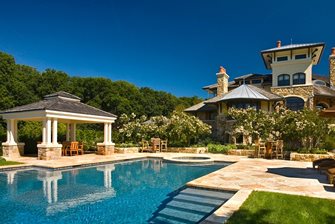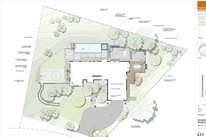Thinking Long-Term
How to ensure your landscape will meet your needs for years to come
Since your family and entertaining needs can change dramatically over time, landscaping projects are most effective when you think of them as a long-term investment which that will need periodic care and updating. Here, Howard Roberts of Liquidscapes, Inc in Pittstown, NJ shares three simple tips to ensure your landscaping will meet your needs for years to come.
First of all, long term thinking can only start with a well thought out plan. From that exercise and document, you should have complete visibility of your project, so you can execute to your greatest benefit.
“Too many times over my 36 years career I have seen homeowners try to skip the design process, which has cost them dearly down the road by not thinking the “Big Picture” through,” Roberts says. “Or they piece meal it and hire individual companies to preform separate services related to the project, but nothing seems to come together in the end because no one was steering the ship,” Roberts says. Classic mistakes and examples are listed below when long term planning doesn’t come into play.
Run extra conduit.
While you may think the landscaping is finished once your current plan is installed, you may find that as your family or work life changes, your habits do as well. By running extra conduit or open sleeves underneath patios and pathways, you can make it easy for yourself if you ever choose to expand your outdoor living areas, add lighting, or change your irrigation setup. This is a very inexpensive cost if you plan ahead of time, but to do it later is not. You may phase your project out, which is fine, but make sure that anything that needs to be installed below grade or will be expensive to access later, should be part of the planning early on (and included in your budget).
Leave access for phasing.
As you live with your landscaping over the years, you may find you'd like to expand or enhance the areas you use most. Given that, it's wise to leave enough room for machinery to access your backyard for any future projects. Removable fence panels, spacious gates, and an access path which doesn't require going over stairs will all make it easier to repair or renovate your landscape. Having limited access is a huge cost factor to any project, so in the planning stages, that needs to be thought through. Don’t forget access for future maintenance requirements as well. Something as simple as pruning or removing a tree can escalate severely in cost if the contractor cannot get their equipment near the chore.
Plan for maintenance.
Just like your home, your landscape needs regular maintenance in order to look its best and function well. Depending on your materials and climate, you may need to fill cracks in patios or pathways, winterize your irrigation system or pool, and train or care for your plantings. Make sure you understand the maintenance needs of your new landscape before you install to ensure you'll be able to keep up your investment over time. Many installation companies also maintain the gardens and properties they install. Roberts suggests asking them for a quote to maintain it, before they build it, so you know what you are up against financially.
The most important aspect of the conversation is, get educated, do not compromise the process, create a solid design that will hold up to the test of time, build it right the first time (better to phase it as you can afford than compromise the integrity), use materials that will work in your region and find the right professionals to support you in achieving your goals.
To see more of Howard's work view the Liquidscapes portfolio.
|
Contributing Author: Genevieve Schmidt, contributing writer for Landscaping Network and owner of North Coast Gardening |




 Tips for Hiring a Landscape Pro
Tips for Hiring a Landscape Pro Landscaping Process
Landscaping Process Finding the Right Designer
Finding the Right Designer

